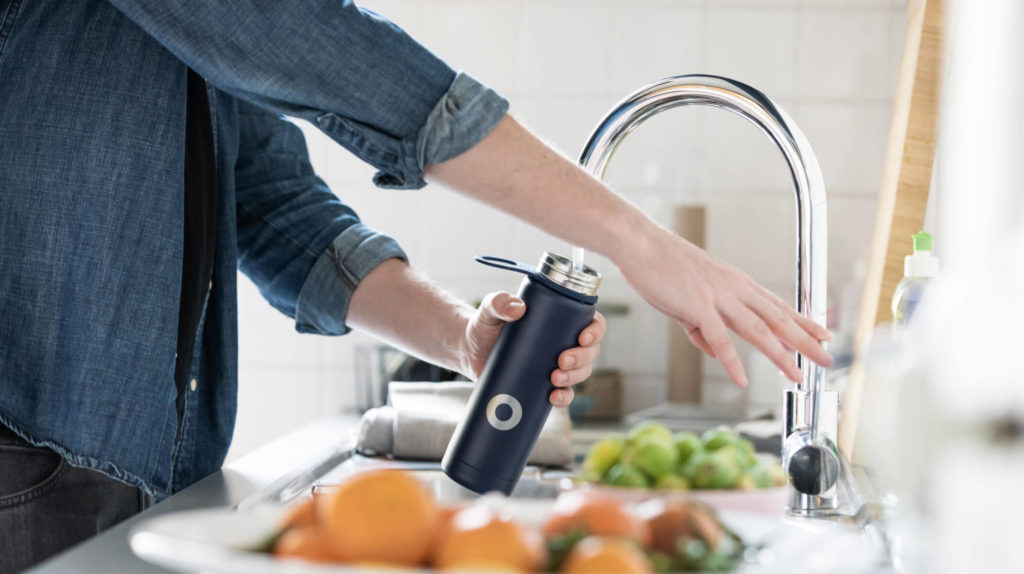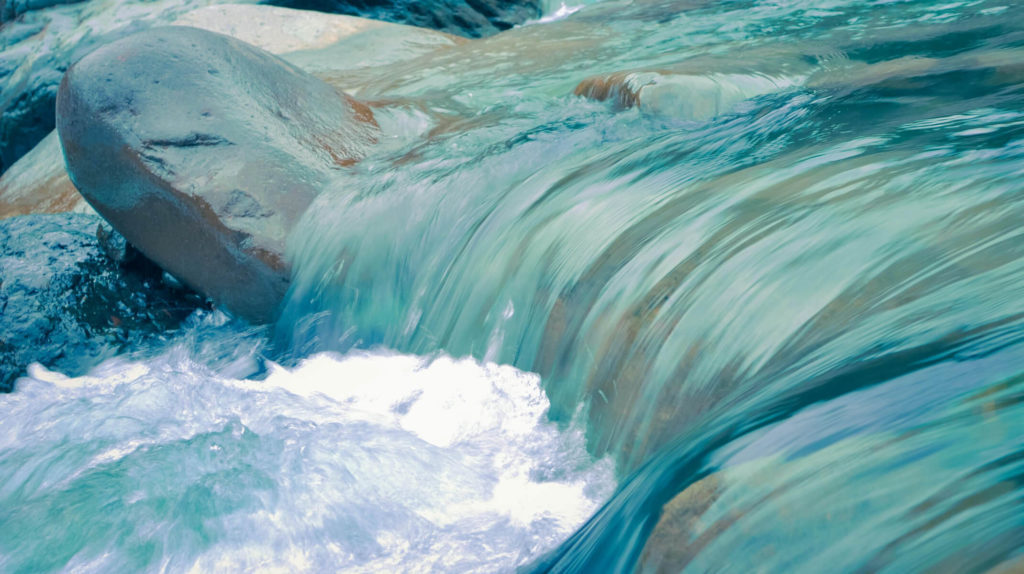Mineral water, alkaline water, distilled water, sparkling water, spring water, tap water – today staying hydrated is more complicated than ever!
How do you decide which one is best for you?
Don’t worry, help is here! When you finish this article, you’ll know more about the water you drink and the water you should be drinking. You’ll know how to make your drinking water part of your complete health and wellness plan.
Turn any water into Chlorophyll water with a few drops a day and multiply the health benefits!
Are all Types of Water Essentially the Same?
There are many different types of drinking water. Some, like distilled water, are pure water with few or no trace elements. Others, like mineral water, contain high amounts of magnesium, potassium, and other important minerals.
Most people get their water from a municipal water supply, but many rely on a well. While pure water has a neutral pH, some people swear by the health benefits of alkaline water.
Pros and Cons of the Different Types of Water
Let’s start with our tap water.
Most of us rely on a municipal water supply. Some municipalities have great tap water, but others do not. Many people have wells. Well water is often healthier and better tasting, but can sometimes be contaminated with chemicals or bacteria.
Now let’s touch on all the types of bottled water.
Mineral water and spring water both originate underground, but mineral water has more dissolved minerals while spring water is less strongly flavored. Sparkling water has carbonation. Alkaline water can settle indigestion but can also make matters worse by encouraging acid production.
There are all kinds of water to choose from, so we’re going to dive into these different types of water so you can make an informed decision. Let’s begin.
1. Tap Water
Most American tap water is considered safe. Municipal water systems are strictly regulated with safeguards in place to prevent contamination. Tap water is used not only for drinking but for bathing, washing clothes, irrigating fields, filling swimming pools, and just about everything else that requires water. And tap water also contains important minerals like copper, calcium, magnesium, and sodium.
One of the biggest disadvantages of bottled water is the cost. Tap water is cheap, convenient, and available with a turn of the faucet. But is it the best choice for your family? And what’s in your local tap water?
Most Common Contaminants
Between 2014 and 2019 Flint, Michigan’s tap water was contaminated with hazardous levels of lead and legionella bacteria. If you were tempted to drink the discolored, foul-smelling stuff coming out of a Flint faucet, you could get violently ill.
While Flint is a particularly notorious case, many Americans are drinking chemical and bacterial cocktails in their tap water. Industrial and agricultural contaminants show up in tap water samples across the nation, especially in underserved and impoverished communities. Those who can least afford the alternatives often live in communities with polluted tap water.
Average Cost of Tap Water
The cost of tap water varies widely depending on your geographic region. People living in Florida pay an average of $6 per month for their water, while people living in West Virginia pay an average monthly water bill of $72.
Your tap water bill will also depend on how much water you use. Between showering, flushing the toilet, washing clothes and dishes, and watering lawns and gardens the average person uses about 85 gallons of water per day. You’d have to drink an awful lot of tap water before you’d start seeing a difference in your water bill.

2. Well Water
Municipal water systems rely on a network of pipes to bring water to your property. If you live in a remote location or have a large property, running a pipe to your building may not be feasible. Landowners who cannot access a public water system must rely instead on well water.
Well water comes from the local aquifer. After drilling a well, a well pump and pressure tank keeps your home supplied with water. Well water contains minerals and nutrients that are filtered by many municipal treatment facilities, leading to water that’s not only healthier but also tastes better.
Most Common Contaminants
Well water may contain heavy metals like iron, manganese, arsenic, cadmium, and lead. Exposure to these metals can cause illnesses like anemia, cancer, and kidney damage.
Chemical and animal fertilizers from farms or lawns can seep into the groundwater and raise nitrate and nitrite levels. Nitrate and nitrite reduce the blood’s ability to carry oxygen, and infants exposed to high nitrate/nitrite levels can become seriously ill.
Runoff from rainfall or snowmelt can wash bacteria, viruses, and parasites into the well or groundwater, as can waste leakage from septic tanks and leach fields. This can lead to gastrointestinal illnesses.
How to Have a Safe Well Water Supply
You will need to test your well water for bacteria, nitrates, and other contaminants every 6-12 months. You should also test when you notice changes in color or taste, or immediately after your septic system malfunctions or fails. Check EPA records for any records of industrial contamination that might cause problems with your local water table.
Your well will require a filtration system. If your local water is especially hard, you may also need to install a water softening system to bring down the pH and a carbon filter to remove chlorine and other bad-tasting contaminants.

3. Mineral Water
For thousands of years, travelers journeyed to spas and baths set up around mineral springs. There they drank and bathed in mineral-rich waters for numerous health benefits. Today the spa travels to you, as there are over 4,000 different brands of mineral water commercially available worldwide.
Mineral waters contain compounds like potassium, calcium carbonate, and magnesium sulfate. Studies suggest that regular consumption of mineral water can reduce cholesterol levels, lower blood pressure, and contribute to bowel regularity and bone health. (If you are on a reduced-sodium diet, you should keep an eye on your chosen mineral water’s sodium levels!)
Cost of Mineral Water Bottles on the Environment
One of the disadvantages of mineral water is environmental damage. Over 80% of the plastic water bottles used in the United States wind up in landfills or as litter. Transporting water from a mineral spring requires enormous amounts of fossil fuels and contributes to global warming.
You can help to soften that blow by recycling your mineral water bottles but be advised that much “recycling” could more accurately be called downcycling. The PET in bottles can be recycled into polyester, but polyester carpets and clothing typically wind up in landfills rather than recycling centers.
Average Cost of Mineral Water
Today an average 20-ounce bottle of water costs $1.50 in most stores. That adds up to $9.60 a gallon, which is a lot more than the $0.004 a gallon the average American pays for tap water. If you start sampling different kinds of waters – specifically the high-end mineral types, you can spend a whole lot more. A liter of Japan’s Fillico Jewelry Water (drawn from a deep well beneath Kobe’s Rokko Mountain) will cost you €49.00, or almost $54. And if you buy that liter in one of their famous crystal-decorated bottles, it will cost €999.00 ($1,100).
4. Distilled Water
Ancient sailors boiled seawater to make drinking water. Today distilled water is used in a number of home and industrial settings. Many seaside facilities still use distillation to transform ocean water into their municipal water supply. In a water distiller, steam rises from boiling water into a tube and into another chamber. As it cools it condenses back into a liquid. Any bacteria or other impurities whose boiling point is above 100° C (212° F) are left behind in the heating chamber. Distilled water is one of the easiest kinds of water to produce.
Distilled Water vs Water Bottle
By distilling water at home, you avoid ecologically unfriendly plastic bottles. Distilled water is free of any impurities. Bottled water is subject to less regulatory scrutiny than municipal tap water, so it’s hard to know exactly what’s in that bottle.
The biggest issue with distilled water is its flat taste. Along with contaminants, distillation strips out minerals that give water its flavor. While most people get all the minerals they need from their food, small children, athletes, and people with serious medical conditions may do better drinking a different kind of water.
Average Cost of Distilled Water
Distilled water is one of the cheapest kinds of water. You can buy distilled water starting at $1.00 a gallon but check the packaging. Because distilled water is so pure, it is a potent solvent and can leach toxic chemicals from plastic bottles. Distilled water should be kept in glass or BPA-free food-grade plastic containers.
For the best results, make your own distilled water at home. Personal water distillers start at around $100. An office-cooler-sized personal water distiller can cost over $2,500. This is a hefty investment, but you will know that your drinking water is pure.
5. Spring Water
The FDA defines “spring water “ as water flowing naturally to the surface from an identified source. While mineral water has a TDS (total dissolved solids) of at least 250 ppm in minerals, spring water contains around 50 ppm. Spring water lacks mineral water’s assertive flavor, but still provides a decent amount of minerals.
Spring water is filtered by layers of sandstone, limestone, and clay as it flows into the groundwater. This removes toxins and bacteria very effectively. Spring water is also regularly sampled and analyzed to ensure it meets FDA and EPA standards before it is bottled and sold.
Mineral and Nutrients Present in Spring Water
Spring water contains magnesium, calcium, and sodium bicarbonate. Calcium is necessary not only for bone and dental health but also for blood clotting, central nervous system function, and muscle development. Sodium bicarbonate aids in digestion and can prevent stomach upset. And magnesium plays a key role in energy production, nerve signaling, and muscular contractions.
One of the disadvantages of spring water is that the concentrations of these minerals vary widely by location. Finding the mineral content in most bottled spring water brands is challenging. And while spring water can provide helpful minerals, it is no substitute for a balanced diet.
Benefits of Drinking Spring Water
Spring water can help you boost your immune system by providing sodium, calcium, magnesium, and potassium. More importantly, drinking spring water regularly in place of sugary sodas or caffeine-laden beverages can improve your mood and help you lose weight. If your tap water doesn’t suit your palate, bottled spring water is a tasty and healthy way to stay hydrated.
Acidic beverages like sodas and energy drinks can raise your body’s pH levels and throw your body off balance. Neutral to slightly alkaline drinks like spring water help your body to keep itself in pH balance and make you feel better.

Similar Read: What Does Chlorophyll Taste Like and How to Make it Taste Better
6. Sparkling Water
Some sparkling waters are naturally carbonated and come from a spring or well. But the carbonation quickly goes away as they come to the surface, just as soda goes flat soon after you open it. Bottlers re-carbonate these waters before packaging them.
Sparkling waters are different from seltzer, artificially carbonated tap water. Neither should you mistake it for club soda, which is tap water carbonated by adding sodium or potassium bicarbonate, or citrate. Natural sparkling waters are generally more expensive than artificially carbonated waters.
Sparkling waters are frequently used to make cocktails or as a refreshing non-alcoholic beverage.
Can Sparkling Water Bring Any Health Benefit?
Carbonation under pressure, whether or not it happens underground, creates water that fizzes when the pressure is released. But does it have any health benefits?
Sparkling waters are no better for you healthwise than any other kind of water. But that’s not really a bad thing, since water is so good for you on its own. And if carbonation makes you drink more water, then carbonation is good for you.
Sparkling waters are a fun and tasty way to drink more water over the course of the day. And living healthier is much easier when you enjoy it.
Why Choose Sparkling Water Over Other Types of Water
Sparkling water remains one of the most enduringly popular of all water types. That fizzy sensation on the tongue adds a dash of ‘je ne sais quoi’ to mixed drinks and non-alcoholic mocktails.
While sparkling waters are not so high in beneficial minerals as mineral waters, they have a more neutral taste that takes well to flavorings. You can find sparkling waters to suit a wide variety of tastes. This versatility makes sparkling water a healthy yet still tasty choice for those moving away from soda and other unhealthy beverages.
If sparkling water is your personal preference, go for it!
7. Alkaline Water
While EPA guidelines state that the pH of tap water should be between 6.5 and 8.5, most tap water in the US still falls in the 4.3 to 5.3 range — as acidic as a cup of black coffee!
Alkaline water has a Ph over 7, while most even have a pH in the 8-9 range. Some claim that alkaline water improves metabolism, slows aging, improves digestion, and reduces bone loss.
While there is some disagreement over alkaline water’s medical benefits, many water drinkers agree that alkaline water tastes sweeter and more refreshing than more acidic water.
Alkalinization and the Process of Controlling pH Levels
Most alkaline water bottlers use a water ionizer to separate the alkaline and acidic parts of water through electrolysis. A water ionizer can provide alkaline water with a pH of up to nine.
Household ionizers are expensive, but ensure a steady supply of alkaline water even if your tap water is acidic.
A simpler way to create alkaline water is to add an alkaline substance like sodium bicarbonate to a container of water. With a pH meter (available at pet and garden stores) and some baking soda, you can turn different types of water into alkaline water at your preferred pH.
Possible Side Effects
While a little alkaline water can soothe gastric reflux and indigestion, too much can lead to gas, bloating, diarrhea, and gastrointestinal infections.
Drinking enough alkaline water to throw your body’s pH out of whack can cause metabolic alkalosis. Symptoms of alkalosis include vomiting, diarrhea, swelling, and fatigue. Severe alkalosis can lead to disorientation, seizures, or even a coma.
If you suffer from liver or kidney disease, consult your physician before starting alkaline water to discuss the advantages and disadvantages of alkaline water.
Alkaline water with a pH over 10 may cause skin problems or eye issues (and will taste awful anyway).

Best Types of Waters to Mix Chlorophyll With
There are many types of waters to choose from, but they all can be used to make refreshing and healthy chlorophyll water.
You will find many recipes telling you how to make chlorophyll water. All you need is a blender or liquidizer, some patience, drinkable water, and lots of green vegetables and plants. (Our recipe uses chlorophyll-rich moringa leaves!)
Short on time and patience? The easiest way to make chlorophyll water is by simply adding some liquid chlorophyll drops to a container of water. To learn more, check out our link on how to use liquid chlorophyll.
Get Excited About Chlorophyll’s Magic
A completely different type of water – Chlorophyll water comes with immense benefits. Liquid chlorophyll in the form of chlorophyll drops can help your body build more red blood cells. Chlorophyll is chemically similar to hemoglobin and may be helpful in treating low iron levels.
Chlorophyll is a natural deodorizer that reduces body odor and can help with bad breath and other embarrassing smells. Chlorophyll has even been used to reduce odors from wounds.
It contains antioxidants and anti-inflammatory compounds that can help your heart health, improve your liver function, and lower your blood pressure.
Possible Side Effects
While chlorophyll supplements are generally safe, some people may experience mild side effects. The most notorious side effect, green stools, is unpleasant but harmless. Chlorophyll can cause stomach upset resulting in nausea, stomach cramps, diarrhea, and vomiting – this tends to happen when you’re taking more than your body requires!
Chlorophyll can also increase your sensitivity to the sun. Some people taking chlorophyll supplements find their skin burns more quickly and intensely in sunlight. If you are taking chlorophyll, be sure to wear sunblock at all times. This effect can be especially severe if you are taking prescription medications that cause photosensitivity. If you are under a doctor’s care, consult your physician.
FAQs
What Kind of Water is the Healthiest?
Of the different water types, mineral water has the highest concentration of healthy minerals and the longest history of being used for health-related purposes. But mineral water can also contain high levels of sodium and may not be suitable for people on restricted-sodium diets. But any sort of clean water is healthier than most sugary or caffeinated drinks, and keeping hydrated should be a big part of everybody’s wellness plan. To add an extra kick of health to your water, try Chlorophyll drops!
Can You Drink Distilled Water?
You can drink distilled water and many water treatment facilities use distilled and desalinated water in their municipal water systems. Many bottled waters are first purified by distillation. The bottlers then add backtrace elements and minerals to give their distilled water a better taste. Distilled water without added minerals is not recommended for very small children or people with illnesses that affect their body’s electrolyte balance.
Where Has the Best Tap Water?
Strict water treatment standards, along with natural springs and 60.5 inches average annual rainfall, give Switzerland what many consider to be the world’s best tap water.
Costa Rica’s filtration plants and pollution-free environment make its tap water the best type of water to drink in the Western Hemisphere.
In the United States, water quality can vary widely from town to town. But Rhode Island, South Dakota, and Missouri are frequently praised for their tap water.
How Many Types of Water Are There?
Many homes and offices rely on tap water. Others get their water from a well. At the supermarket, you can find sparkling water, mineral water, carbonated water, bottled water, tonic water, alkaline water, and many different flavored waters. When you are at the ocean you are swimming in saltwater. When you jump in a lake you’re swimming in freshwater. If you’re wading through coastal swamps you’re in brackish water – watch out for alligators!
What Type of Water Is Best to Drink?
The answer to the question “What is the best type of water to drink” is “the type of water you enjoy drinking!” Water choice is a matter of personal preference. The important thing is that you drink enough water to keep your body hydrated and all your systems in balance. Drink whatever water suits your fancy, be it from a spring, a well, a bottle, or even add Chlorophyll supplements for an extra health kick! Just make sure you drink plenty of water throughout the day.

